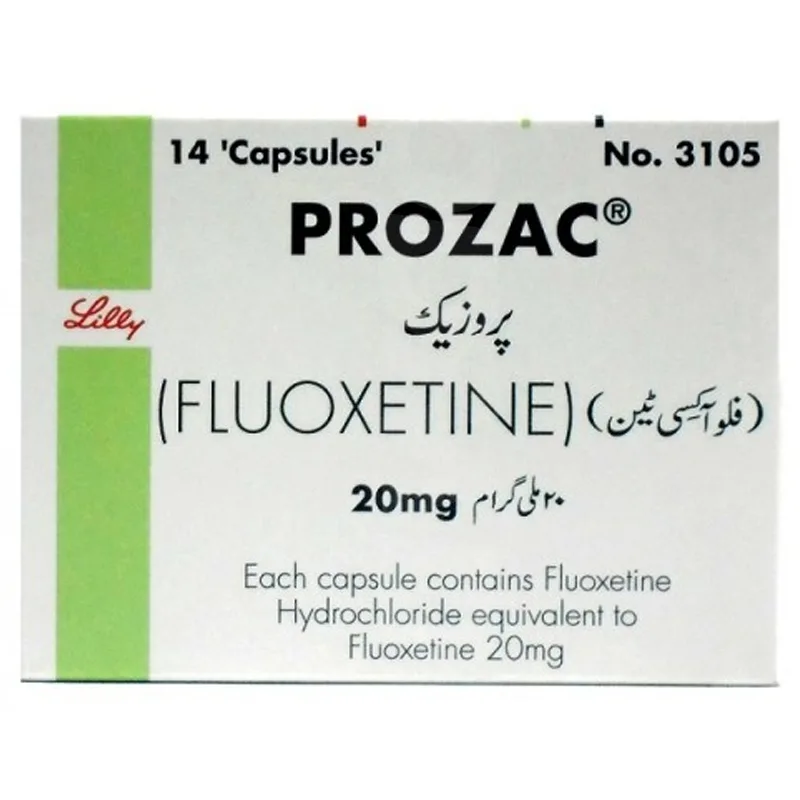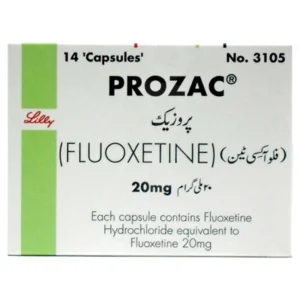
Fluoxetine, commonly known by its brand name Prozac, is one of the most widely prescribed medications for mental health disorders. As a selective serotonin reuptake inhibitor (SSRI), fluoxetine is primarily used to treat different conditions like depression, anxiety, and obsessive-compulsive disorder (OCD). This article provides a detailed examination of fluoxetine, its uses, dosage, side effects, and important considerations for patients.
What is Fluoxetine?
Fluoxetine is a drug that belongs to the class of drugs called selective serotonin reuptake inhibitors (SSRIs). Selective serotonin reuptake inhibitors (SSRIs) work by elevating the release of serotonin, a neurotransmitter that is crucial for the regulation of mood. By boosting serotonin levels in the brain, fluoxetine helps alleviate symptoms of depression and anxiety.
Uses of Fluoxetine
Fluoxetine has following uses.
- Major Depressive Disorder:
Fluoxetine is often prescribed to patients diagnosed with depression to reduce symptoms such as sadness, fatigue, and loss of interest in daily activities.
- Generalized Anxiety Disorder (GAD):
People suffering from excessive worry and anxiety may benefit from fluoxetine’s calming effects.
- Obsessive-Compulsive Disorder (OCD):
Fluoxetine helps reduce the obsessive thoughts and compulsive behaviors associated with OCD.
- Panic Disorder:
It can help decrease the frequency and severity of panic attacks.
- Bulimia Nervosa:
Fluoxetine may also be prescribed to those struggling with eating disorders, particularly bulimia, to help curb compulsive behaviors.
Mechanism of Action
Fluoxetine acts by blocking the reabsorption of serotonin within the brain. Normally, nerve cells release serotonin to transmit signals, but it is quickly reabsorbed. Fluoxetine prevents this reabsorption, that results in increased levels of serotonin in the synaptic gap, which promote communication between nerve cells and positively affects mood and emotional well-being.
How Long Does It Take to Work?
Patients may begin to observe some improvement in their symptoms within 1 to 2 weeks of starting fluoxetine. However, the complete therapeutic effects can take up to 6-8 weeks to manifest. It is required by patients to be patient and continue taking the medication as prescribed, even if immediate results are not seen.
Dosage and Administration
Fluoxetine is typically taken orally, either in the form of a capsule, tablet, or liquid. The dosage differs according to the condition being treated and the patient’s response to the medication.
Typical Dosage Guidelines
- Depression:
The standard initial dosage for depression is 20 mg administered once per day. Depending on the patient’s response, the dose may be increased gradually up to 40 mg to 60 mg per day.
- Anxiety or Panic Disorder:
A starting dose of 10 mg to 20 mg per day is common. The dose may increase gradually depending on effectiveness and tolerance.
- Obsessive-Compulsive Disorder:
A typical starting dose is 20 mg daily, with potential increases based on the patient’s needs.
It’s necessary to follow a healthcare provider’s instructions regarding dosage and not to change the dosage without consultation. Abrupt discontinuation of fluoxetine can produce withdrawal symptoms, so make changes to the regimen gradually.
Side Effects of Fluoxetine
Like all medications, fluoxetine can have side effects. These can vary in intensity from mild to severe.
Common Side Effects
- Nausea
- Headache
- Dry mouth
- Insomnia
- Drowsiness
- Loss of appetite
These side effects typically diminish as the body adjusts to the medication over time.
Serious Side Effects
While rare, some patients may experience severe side effects, including:
- Suicidal thoughts:
Usually in young adults and adolescents, fluoxetine may induce the risk of suicidal ideation.
Serotonin syndrome is a serious medical condition that can be life-threatening, due to the accumulation of serotonin in the brain. The symptoms linked with this syndrome may include agitation, confusion, increased heart rate, and elevated blood pressure.
- Severe allergic reactions:
Rash, itching, or swelling, particularly of the face, throat, or tongue.
Patients should get immediate medical attention in above mentioned cases.
Drug Interactions of Fluoxetine
It can interact with other medications, which may change its effectiveness or increase the risk of side effects. Some important drug interactions include:
- Monoamine oxidase inhibitors (MAOIs): Taking fluoxetine with MAOIs can result in dangerous interactions provoking serotonin syndrome.
- Other SSRIs: Combining fluoxetine with other SSRIs can surge the risk of serotonin syndrome and other side effects.
- Blood thinners (e.g., warfarin): Fluoxetine may escalate the blood-thinning effect, increasing the risk of bleeding.
It’s essential for patients to dictate about all medications with health professional, both prescription and over-the-counter, that they are taking at that particular time.
Popular Brands of Fluoxetine
Fluoxetine has several brand names and formulations. Below is a table of the popular brands and their specifications:
| Brand Name | Formulation | Strength Options | Manufacturer | Notes |
| Prozac | Capsule, Tablet | 10 mg, 20 mg, 40 mg | Eli Lilly | The original and most well-known brand |
| Sarafem | Capsule | 10 mg, 20 mg | Eli Lilly | A variant marketed for PMDD (Premenstrual Dysphoric Disorder) |
| Selfemra | Capsule | 10 mg, 20 mg | Amgen | Generic version, available in some regions |
| Fluoxetine | Tablet, Liquid | 10 mg, 20 mg, 40 mg | Multiple Generic Manufacturers | Affordable generic option |
Special Considerations
- Pregnancy and Breastfeeding: Fluoxetine is a Category C medication for pregnancy as its effects on an unborn child are not fully known.
- Older Age Patients: Older adults can have more effects of fluoxetine, so dosages are typically started lower and monitored closely.
Conclusion
Fluoxetine (Prozac) is an effective and widely used medication for treating various mental health conditions. Understanding how it works, its potential side effects, and the importance of proper dosing can help patients achieve the best possible outcomes. As with any medication, communication with a healthcare provider is key to ensuring safe and effective treatment. Always consult a doctor before making any changes to your medication regimen.




